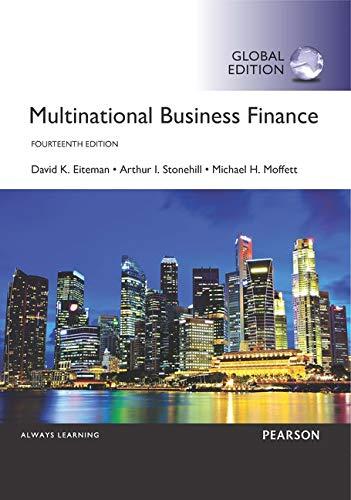Novo is a Danish multinational firm that produces industrial enzymes and pharmaceuticals (mostly insulin). In 1977, Novos
Question:
Novo is a Danish multinational firm that produces industrial enzymes and pharmaceuticals (mostly insulin). In 1977, Novo’s management decided to “internationalize” its capital structure and sources of funds. This decision was based on the observation that the Danish securities market was both illiquid and segmented from other capital markets. In particular, the lack of availability and high cost of equity capital in Denmark resulted in Novo having a higher cost of capital than its main multinational competitors, such as Eli Lilly (U.S.), Miles Laboratories (U.S.—a subsidiary of Bayer, Germany), and Gist Brocades (the Netherlands).
Apart from the cost of capital, Novo’s projected growth opportunities signaled the eventual need to raise new longterm capital beyond what could be raised in the illiquid Danish market. Since Novo is a technology leader in its specialties, planned capital investments in plant, equipment, and research could not be postponed until internal financing from cash flow became available. Novo’s competitors would preempt any markets not served by Novo.
Even if an equity issue of the size required could have been raised in Denmark, the required rate of return would have been unacceptably high. For example, Novo’s price/
earnings ratio was typically around 5; that of its foreign competitors was well over 10. Yet Novo’s business and financial risk appeared to be about equal to that of its competitors.
A price/earnings ratio of 5 appeared appropriate for Novo only within a domestic Danish context when compared with other domestic firms of comparable business and financial risk.
If Denmark’s securities markets were integrated with world markets, one would expect foreign investors to rush in and buy “undervalued” Danish securities. In that case, firms like Novo would enjoy an international cost of capital comparable to that of its foreign competitors. Strangely enough, no Danish governmental restrictions existed that would have prevented foreign investors from holding Danish securities.
Therefore, one must look for investor perception as the main cause of market segmentation in Denmark at that time.
At least six characteristics of the Danish equity market were responsible for market segmentation: (1) asymmetric information base of Danish and foreign investors, (2) taxation, (3) alternative sets of feasible portfolios, (4) financial risk, (5) foreign exchange risk, and (6) political risk.
Asymmetric Information Certain institutional characteristics of Denmark caused Danish and foreign investors to lack information about one another’s equity securities. The most important information barrier was a Danish regulation that prohibited Danish investors from holding foreign private sector securities. Therefore, Danish investors had no incentive to follow developments in foreign securities markets or to factor such information into their evaluation of Danish securities. As a result, Danish securities might have been priced correctly in the efficient market sense relative to one another, considering the Danish information base, but priced incorrectly considering the combined foreign and Danish information base. Another detrimental effect of this regulation was that foreign securities firms did not locate offices or personnel in Denmark, since they had no product to sell there. Lack of a physical presence in Denmark reduced the ability of foreign security analysts to follow Danish securities.
A second information barrier was that there were too few Danish security analysts following Danish securities.
Only one professional Danish securities analysis service was published (Børsinformation), and that was in the Danish language. A few Danish institutional investors employed in-house analysts, but their findings were not available to the public. Almost no foreign security analysts followed Danish securities because they had no product to sell and the Danish market was too small (small-country bias).
Other information barriers included language and accounting principles. Naturally, financial information was normally published in the Danish language using Danish accounting principles. A few firms, such as Novo, published English versions, but almost none used U.S. or British accounting principles or atte......
Mini-Case Questions 1. What were the impacts on Novo as a result of operating in a segmented market?
2. What were the primary causes of the market segmentation?
3. Ultimately, what actions did Novo take to escape its segmented market?
Step by Step Answer:

Multinational Business Finance
ISBN: 9781292097879
14th Global Edition
Authors: David Eiteman, Arthur Stonehill, Michael Moffett





